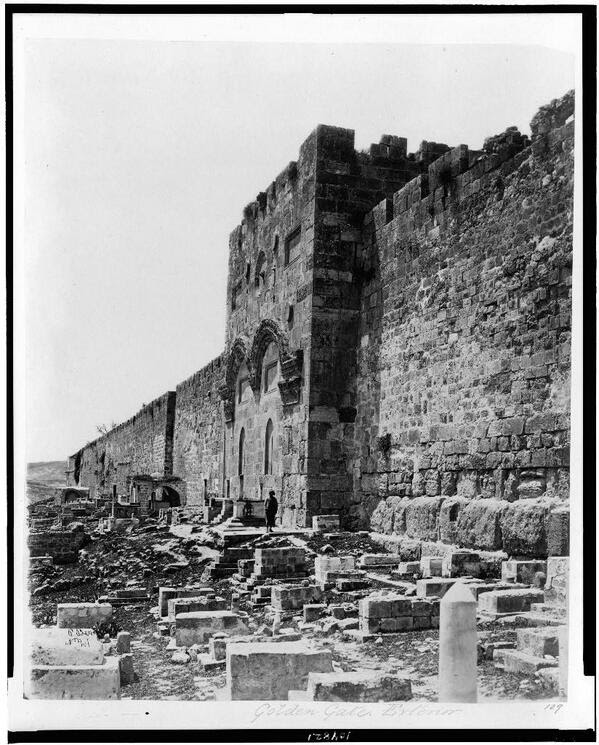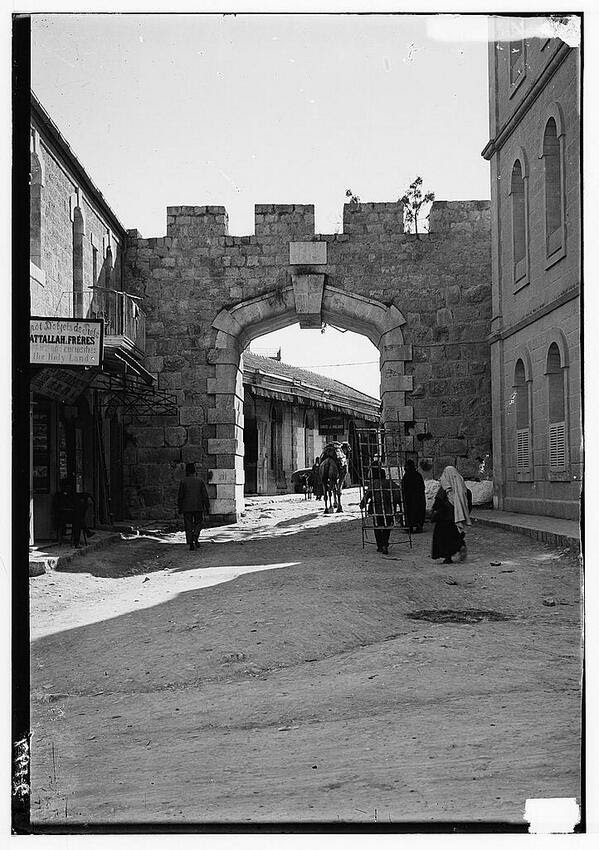Showing posts with label Zion Gate. Show all posts
Showing posts with label Zion Gate. Show all posts
Tuesday, November 6, 2018
Sunday, October 14, 2018
Jerusalem, Old City, Zion Gate 10.14.18 - video
Category
Monday, July 23, 2018
Israel's History - a Picture a Day (Beta) The Gates of Jerusalem Then and Now (Part I) - Zion Gate
Israel's History - a Picture a Day (Beta) |
|
Posted: 22 Jul 2018 09:30 PM PDT
Updating first posting in Israel Daily Picture in preparation for Book 3, Jews and Holy Sites in the Holy Land, Revealed in Early Photographs.
The walls of Jerusalem's Old City that we see today were built in 1540 during the days of the Ottoman Sultan, Suleiman the Magnificent. The location and name "Zion Gate" appear on maps dating back to the 12th century. It is one of eight gates in the Old City Wall.
On May 28, 1948 the Jewish Quarter surrendered. Jews were expelled through Zion Gate and didn't return until the city of Jerusalem was reunited 19 years later in the June 1967 war.
| ||||||||||||||
|
Posted: 22 Jul 2018 05:37 AM PDT
Tisha B'Av is commemorated today (on the 10th of Av), Sunday July 22, 2018.
The ninth day of the Hebrew month of Av -- Tisha B'Av -- is the day in the Hebrew calendar when great calamities befell the Jewish people, including the destruction of both Temples in Jerusalem, the fall of the fortress Beitar in the Jewish rebellion against Rome in 136 CE, and the expulsion of Jews from Spain in 1492. The day is commemorated with fasting, prayers and the reading of Lamentations. In Jerusalem, thousands pray at the Kotel, the Western Wall.
The American Colony photographers frequently focused their cameras on the worshipers at the "Wailing Place of the Jews." The Colony founders who came to Jerusalem in 1881 were devout Christians who saw the return of the Jews to the Holy Land as a sign of messianic times.
Of the dozens of pictures at the Kotel there are several of elderly men and women sitting on the ground or on low stools, customs of mourning practiced on Tisha B'Av.
Other pictures presented here show the very narrow and confined area of the Kotel over the ages until Israel's army captured the Old City in 1967 and enlarged the Kotel plaza.
The tragedies that occurred to the Jewish nation are also evident in the pictures of the deserted plaza after Arab pogroms in 1929. The area was deserted, of course, during the 19 years of Jordanian rule of the Old City when Jews were forbidden to pray at the site.
A story is told of Napoleon passing a synagogue and hearing congregants inside mourning. To his question who they are mourning, he was told they were weeping over the destruction of the Jewish Temple 1,800 years earlier. Napoleon responded, according to the legend, "If the Jews are still crying after so many hundreds of years, then I am certain the Temple will one day be rebuilt."
Dedicated in memory of Chaim Menachem ben Levi |
Friday, April 24, 2015
Life and Death of a Jewish Courtyard in Jerusalem's Old City
Israel's History - a Picture a Day (Beta) |
|
Posted: 23 Apr 2015
The picture of this Jerusalem courtyard in the Jewish Quarter of the Old City was taken by a German army photographer during World War I and was found in the British Imperial War Museum. Jerusalem at the time was ruled by the Ottomans.
The distinctive arches on the building on the right identify it as the Rothschild Building, part of the Batei Machaseh compound built for Jewish residents of the Jewish Quarter. It was donated by Baron Wilhelm Karl de Rothschild of Frankfurt. The building still bears the Rothschild family's coat of arms. The compound was built between 1860 and 1890 to provide housing for Jerusalem's poor.
The Rothschild Building appears in a series of dramatic Life Magazine photographs taken by John Phillips during the Jordanian capture of the Old City during the 1948 war. The arches can be seen on the left side of these pictures; the picture above was a reverse view of the ones below. The first was taken in the midst of the fighting in June 1948, and the Jews are seen gathering their belongings for their evacuation. The second picture, taken in July 1948, shows the looting that took place. The pictures appear in the DaledAmos blog.
Phillips' last picture shows the Jews' evacuation from the Old City under the guard of Jordanian Legionnaires. The Rothschild Building serves as the backdrop to the tragic picture.
|
Thursday, May 29, 2014
The Gates of Jerusalem's Old City -- In Honor of "Jerusalem Day"
Israel's History - a Picture a Day (Beta) |
Wednesday, March 26, 2014
Jerusalem Photos - from Love For His People's Ahava Adventure
Steve Martin
Love For His People
Jerusalem Park
Pine tree near Kidron Valley
- it forms the Hebrew letter "shin"
Zion Gate into the Old City near Jewish Quarter
Church in the Armenian Quarter
King David stature near his tomb, which is close by
the Last Supper location.
Jewish Quarter's older men...
...and young kids.
Gathering in plaza near the Cardo (Jewish Quarter)
A few sheep and camels
Shwarma!
The Western Wall (Kotel)
Meat (lamb, turkey, beef) cooking
in preparation for shwarma sandwiches.
Pomegranates and lemons
Walking home from school outside the Old City
A look back up the road to the
Lion's (St. Stephen's) Gate
- Old City, Jerusalem
Wednesday, January 15, 2014
Everyday Life of Jews in Jerusalem's Old City 120 Years Ago - Israel's History - a Picture a Day (Beta)
Israel's History - a Picture a Day (Beta) |
|
Posted: 15 Jan 2014
 The oldest pictures of Jews at the Western Wall in Jerusalem's Old City date from the 1850s, such as this photo taken by Mendel Diness. (With permission of Special Collections, Fine Arts Library, Harvard University. 1859)
Many of the century-old photos of the Jews of the Holy Land were taken during their prayers at the Kotel. Far fewer were the less formal pictures of their everyday life in Jerusalem. We present such pictures here. What did everyday life look like? Close scrutiny of the "Bazaar in Jerusalem" shows Jewish men (and probably Jewish women in the foreground) shopping and walking past a parked camel in the shuk of the Old City. See the enlargement below.
Smeared cotton (not clear what it was "shmeared" with)
Readymade quilts or covers
Mattresses – Best Sorts
The last line are the names of the store's proprietors, but all that can be easily read is "Chaim Tzvi."
The setting inside the Jaffa Gate would again appear in later pictures showing the evacuation of Jews from the Old City during Arab rioting in 1929 and 1936. (Note the tree in the pictures above and below.) In 1948, the Old City Jews were expelled through the Zion Gate.
|
Subscribe to:
Comments (Atom)



















































